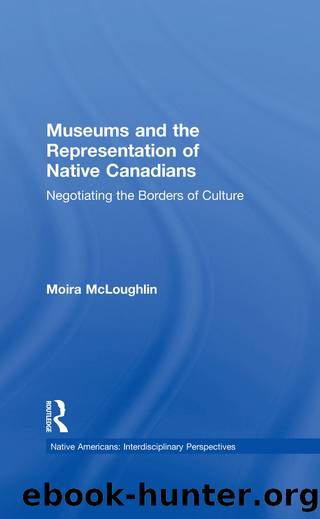Museums and the Representation of Native Canadians by Moira McLoughlin

Author:Moira McLoughlin [McLoughlin, Moira]
Language: eng
Format: epub
Tags: History, General, Social Science, Minority Studies, Discrimination
ISBN: 9781317732228
Google: unp0DwAAQBAJ
Publisher: Routledge
Published: 2018-10-24T01:33:16+00:00
Myth vs. Science: Where Does the Future Lie?
As mentioned earlier, the Manitoba Museum of Man and Nature is also the only museum in the sample to attempt to integrate both an Euro-Canadian and Native Canadian voice into its exhibits. It is an exhibit strategy, I would argue though, that does not entirely escape the problematic binary identified in chapter one that constructs the cultural Other. While the presence here of Native voice suggests the equal authority of its narratives, the language used in its translation often undermines this intention. As described earlier, the Odawa creation story follows the orientation gallery and works to open the narrative of the following exhibits. According to that story, North America was created by Wee-sa-Kay-Jac, "hero of the Algonkian peoples," from the devastation left behind after a great flood.
The little muskrat disappeared out of sight. Everyone waited anxiously. Hours went by and they were all becoming worried. Finally his drowned little body floated to the surface. Wee-sa-Kay-Jac pried open his paws and there he found a tiny lump of mud. He called to the turtle and put the mud on his shell, and began to knead it with his hands. It started to grow bigger and bigger until it became a large mountain, and then he broke it and spread it all about.... The Great Spirit Manitou was very proud of his people for being so brave. There broke forth bright sunshine like you see after a storm, and all the world was warm again.
As one moves into the Earth History gallery, a second alternative explanation of "man's entry into the New World" is offered: the Bering Land Bridge exhibit (Figure 4-16). However, this alternative is not prefaced by a description of the role of "myth, legend and spoken history" in culture, as was the Odawa creation story. We can assume from the tenor of this voice that it is simply fact.
Possibly as early as 30,000 years ago, during the later part of the Ice Age, the ancestors of today's Indians began entering North American through an ice free route along the eastern edge of the Rocky Mountains. Our knowledge of these early peoples derives from archaeological investigation of their ancient campsites. Onion Portage, located in northwest Alaska, is one of the most informative of the northern sites for it provides a record of human habitation going back about 10,000 years.
While the two stories are not necessarily mutually exclusive, the second narrative constitutes a "record," rather than "historic tradition" or "myth," verifiable not simply in imagination, but in archaeological measures and to our very eyes.
This apparent separation of fact from legend, occurs again in the loon exhibit where a video tape presentation sets out, in a male voice that is clearly identifiable as Native Canadian, the "myth of how the loon got its flat back." After a winter of poor hunting, Wee-sa-kay-jak tricked a group of birds into dancing to his song and to his instructions.
Close your eyes, close your eyes, close your eyes.... Lie over on your backs, Lie over on your backs, Lie over on your backs.
Download
This site does not store any files on its server. We only index and link to content provided by other sites. Please contact the content providers to delete copyright contents if any and email us, we'll remove relevant links or contents immediately.
| Africa | Americas |
| Arctic & Antarctica | Asia |
| Australia & Oceania | Europe |
| Middle East | Russia |
| United States | World |
| Ancient Civilizations | Military |
| Historical Study & Educational Resources |
Machine Learning at Scale with H2O by Gregory Keys | David Whiting(4194)
Never by Ken Follett(3799)
Fairy Tale by Stephen King(3222)
The Man Who Died Twice by Richard Osman(2998)
Oathbringer (The Stormlight Archive, Book 3) by Brandon Sanderson(2899)
Will by Will Smith(2795)
Rationality by Steven Pinker(2291)
The Dark Hours by Michael Connelly(2246)
Can't Hurt Me: Master Your Mind and Defy the Odds - Clean Edition by David Goggins(2230)
Friends, Lovers, and the Big Terrible Thing by Matthew Perry(2126)
The Dawn of Everything: A New History of Humanity by David Graeber & David Wengrow(2123)
Principles for Dealing With the Changing World Order: Why Nations Succeed and Fail by Ray Dalio(1974)
HBR's 10 Must Reads 2022 by Harvard Business Review(1779)
A Short History of War by Jeremy Black(1764)
Go Tell the Bees That I Am Gone by Diana Gabaldon(1689)
515945210 by Unknown(1602)
A Game of Thrones (The Illustrated Edition) by George R. R. Martin(1594)
Kingdom of Ash by Maas Sarah J(1529)
443319537 by Unknown(1472)
